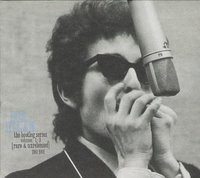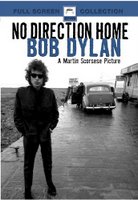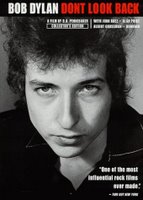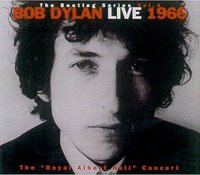Get Your Kicks on Dylan 66
 Blame it on Robyn Hitchcock. Ever since I picked up Robyn Sings, his tribute to Bob Dylan in general and the Bard of Hibbing, Minnesota's legendary 1966 "Royal Albert Hall" concert in particular, I've been obsessing over vintage Dylan circa 1966. All week I've been reading his bestselling biography Chronicles, Vol. 1, watching Martin Scorcese's great PBS "American Masters" documentary No Direction Home, and listening to the original 1966 "Royal Albert Hall" Concert album (actually recorded at Free Trade Hall in Manchester, England - but with a bootleg so storied in legend, glossing over such petty concerns as geography seems rather fitting).
Blame it on Robyn Hitchcock. Ever since I picked up Robyn Sings, his tribute to Bob Dylan in general and the Bard of Hibbing, Minnesota's legendary 1966 "Royal Albert Hall" concert in particular, I've been obsessing over vintage Dylan circa 1966. All week I've been reading his bestselling biography Chronicles, Vol. 1, watching Martin Scorcese's great PBS "American Masters" documentary No Direction Home, and listening to the original 1966 "Royal Albert Hall" Concert album (actually recorded at Free Trade Hall in Manchester, England - but with a bootleg so storied in legend, glossing over such petty concerns as geography seems rather fitting). And I started musing...Was any pop musician cooler than Dylan in 1966?
And I started musing...Was any pop musician cooler than Dylan in 1966? - Maybe Elvis in '56. (But Dylan would never have later joined the Army or gotten fat.)
- Maybe The Beatles conquering America in 1964.(But the Beatles - at least John Lennon - always wanted to be Dylan, and without him there would have been no change in direction from cute to cool as evidenced in Rubber Soul; what, after all, is "Norwegian Wood" but a Dylan song wanna-be, or "I'm a Loser," for that matter? The Beatles were at the top of the game in 1966, but were cautiously looking over their shoulders to see what Dylan was doing. If Bob smoked pot, they had to try it. If he added country twangs to his repetoire, they had to answer with, I dunno, Ringo singing "Act Naturally."
- Maybe Marc Bolan in 1972. (But Bob had the frizzed out fro hair and the suits way before T. Rexmania and - been there, done that - had already made the shift from folkie to Electric Warrior that Bolan was to replicate in his transition from Tyranosaurus Rex to T.Rex.)

But looking at Dylan on the 1966 UK Tour - playing in his green checked suit with his wiggy fro and Raybans and tab-collared polka dots shirts - I don't think so.
Maybe only the Dylan of 65 came close.
Get Your Jive On Dylan 65
 This was the period when he first went electric on Bringing It All Back Home and Highway 61 Revisited and caused the big ruckus at the Newport Folk Festival that turned peacenik Pete Seegar almost violent (see Robert Shelton's description: "Dylan Goes Electric"). '65 was a dry run, in terms of attitude, fashion, and music for the climactic finale of 1966, when Dylan ruled the world. Besides going electric, he also went eclectic (having lost interest in the narrow, topical vision of the Folk/Protest Movement). It was the year when he first toured England to go head-to-head with their folk-rock troubadour, Donovan, and came out the clear victor. And it was the year he had his first No. 1 record ("Like a Rolling Stone" - OK, technically it only made it to No. 2 but it was behind the Beatles, who were untouchable immortals then, so it was virtually No.1 for a mere mortal!).
This was the period when he first went electric on Bringing It All Back Home and Highway 61 Revisited and caused the big ruckus at the Newport Folk Festival that turned peacenik Pete Seegar almost violent (see Robert Shelton's description: "Dylan Goes Electric"). '65 was a dry run, in terms of attitude, fashion, and music for the climactic finale of 1966, when Dylan ruled the world. Besides going electric, he also went eclectic (having lost interest in the narrow, topical vision of the Folk/Protest Movement). It was the year when he first toured England to go head-to-head with their folk-rock troubadour, Donovan, and came out the clear victor. And it was the year he had his first No. 1 record ("Like a Rolling Stone" - OK, technically it only made it to No. 2 but it was behind the Beatles, who were untouchable immortals then, so it was virtually No.1 for a mere mortal!). 
Taken together, 1965-1966 was a double A-side, a time capsule that provided the creme de la creme of the footage for the two great documentaries made about him - D.A. Pennebacker's cinema verite classic Don't Look Back (chronicling 1965's first UK Tour) and now Scorcese's No Direction Home. Pennebaker said he wanted to make a film about Dylan because everytime he hear or saw him, he found himself wanting to know why this musician inexplicably held his attention.
 Of the film's fly-on-the-wall "as is" style, Pennebaker commented, "Dylan's great strength is in the questions he leaves unanswered. It never occurred to me to supply information in the film." As Dylan said at the time, "You are what you think you are." The essence of existentialism, and Dylan was living it, not just writing and singing about it.
Of the film's fly-on-the-wall "as is" style, Pennebaker commented, "Dylan's great strength is in the questions he leaves unanswered. It never occurred to me to supply information in the film." As Dylan said at the time, "You are what you think you are." The essence of existentialism, and Dylan was living it, not just writing and singing about it.
The highlight of Scorcese's film is the found footage, specifically Pennebaker's 1966 UK Tour footage with Dylan backed by The Hawks (the nascent form of what would become The Band) - footage previously only seen in Dylan's incomprehensibly edited (with Howard Alk) would-be-TV-special fiasco Eat the Document (barely viewable bootleg copies of which have been in circulation for years). Fittingly, Scorcese's film comes to a stop with Dylan's career ascendant in '66.
 Don't Look Forward
Don't Look ForwardBy 1966, Sisyphus had rolled his stone to the top of the mountain and there was nowhere else to go but down. Icarus had flown too close to the Sun and gotten burned out. Stunned by the booing of his split acoustic-electric fans - Dylan's 1966 tour of Europe created more controversy and artistic debate than any other tour to date - Orpheus had looked behind him (Don't Look Back!) and was seduced by Death, ready to self-destruct. Dylan had become iconic, the stuff of myth and legend - at one point a reporter actually asked him to explain the meaning and "message" of the Triumph motorcycle t-shirt he wore on the cover of Highway 61 Revisited (a la Bowie's "Space Oddity": Ground control to Major Tom, the Press wants to know whose shirts you wear)! - and like all mythological heroes, he had to suffer the inevitable punch-line, his tragic come-uppance. He was a fait accompli, a done deal. A natural stage actor, he was now cracked actor, and he wanted to recast and reinvent himself, to understudy new roles. And he did. He became invisible and disappeared at the height at his career. To Woodstock. It may have taken a lot to laugh and a train to cry, but it took a motorcycle accident (July 29, 1966) to put out the flames of this wheel on fire. But don't worry Ma, he was only bleeding.
 Blonde On Blonde was Dylan's only 1966 studio recording (the 1966 "Royal Albert Hall" Concert was a bootleg and even Columbia/Legacy Recording's 1998 CD reissue of it is officially called Bob Dylan Live 1966: The "Royal Albert Hall" Concert—The Bootleg Series Vol. 4) and it's not my favorite by any means. But it does contain "Visions of Johanna" and "Fourth Time Around" (which the paranoid John Lennon thought was a spoof of "Norwegian Wood") and that great photo of Dylan looking cold (literally way beyond "cool") in his checkered scarf. But otherwise, it was too long, a double album that found Dylan exhausting the possibilities of the electric sound to excess and while lyrically still showcasing his mad skills, some songs just seemed like exercises in cleverness without meaning, empty gestures ("Stuck Inside of Mobile with the Memphis Blues Again"). I mean, what was "Rainy Day Women #12 and 35" but a self-indulgent throwaway tune? I know I'm talking heresy to Dylanologists, but there was always something in this record as a whole that just didn't do it for me.
Blonde On Blonde was Dylan's only 1966 studio recording (the 1966 "Royal Albert Hall" Concert was a bootleg and even Columbia/Legacy Recording's 1998 CD reissue of it is officially called Bob Dylan Live 1966: The "Royal Albert Hall" Concert—The Bootleg Series Vol. 4) and it's not my favorite by any means. But it does contain "Visions of Johanna" and "Fourth Time Around" (which the paranoid John Lennon thought was a spoof of "Norwegian Wood") and that great photo of Dylan looking cold (literally way beyond "cool") in his checkered scarf. But otherwise, it was too long, a double album that found Dylan exhausting the possibilities of the electric sound to excess and while lyrically still showcasing his mad skills, some songs just seemed like exercises in cleverness without meaning, empty gestures ("Stuck Inside of Mobile with the Memphis Blues Again"). I mean, what was "Rainy Day Women #12 and 35" but a self-indulgent throwaway tune? I know I'm talking heresy to Dylanologists, but there was always something in this record as a whole that just didn't do it for me. It's better to remember Dylan Vintage '66 by his Live 1966: The "Royal Albert Hall" Concert—The Bootleg Series Vol. 4 performances. After being called "Judas" by a folkie heckler, he retorts "I don't believe you!" and then tells The Hawks to "Play fucking loud!"
It's better to remember Dylan Vintage '66 by his Live 1966: The "Royal Albert Hall" Concert—The Bootleg Series Vol. 4 performances. After being called "Judas" by a folkie heckler, he retorts "I don't believe you!" and then tells The Hawks to "Play fucking loud!" It's better to burn out, than to fade away. My my, hey hey. So Dylan 66 went out with a bang, not a whimper. And while all the King's horses and all the King's men - if not uber-manager Albert Grossman just by himself! - may have been able to put the post-crash Dylan back together again, there really was no point. The King had lost interest and already abdicated his Throne.
Related link:
Like the Night (C.P. Lee's account of the May 17, 1966 Manchester Free Trade Hall concert)

1 Comments:
In Mauritius, everyone finds their own personal dream beach - no matter whether bathing beauty, water sports or sunbathing.
Post a Comment
<< Home